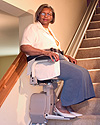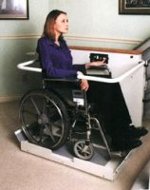Choosing the Right Lifting Aid
Published by Stephen on August 9, 2010 Under Lifting AidsIn the home, a staircase can present risks to people of all ages. Falls on the stairs are often very serious, in part because of the hard surface of the staircase, which, when combined with the height and length of a staircase, can be deadly. Even though people of all ages can experience a fall and serious injury on the stairs, seniors are at the most risk for a fall and serious injury on the stairs.
One of the reasons that elderly people are at such a risk for serious injuries on the stairs is because many seniors have calcium deficiencies, referred to as osteoporosis, which causes the bones to become much more brittle. As a result, even very small falls can result in a broken bone, with hip and knee fractures being very common. So, even simply falling onto one of the steps can easily result in a broken bone, while a fall down the entire staircases often results in much more serious injuries.
For a senior, recovering from these types of injuries can have a major impact on their life and many times necessitates a change in care or a move to an assisted living facility.
Using a Stair Lift
 To help prevent falls on the stairs, many seniors choose to install a stair lift, which is a type of home medical equipment designed to bring a single person up and down the stairs safely and easily. Stair lifts are sort of like having your own residential escalator, except instead of the staircases treads moving, as they do on an escalator, a stair lift uses a small plastic chair to move its occupant up and down the stairway.
To help prevent falls on the stairs, many seniors choose to install a stair lift, which is a type of home medical equipment designed to bring a single person up and down the stairs safely and easily. Stair lifts are sort of like having your own residential escalator, except instead of the staircases treads moving, as they do on an escalator, a stair lift uses a small plastic chair to move its occupant up and down the stairway.
Most stair lifts require that an aluminum track is attached to the side of the staircases, although in areas with very limited space or on curved staircases, the metal track is attached to the wall instead of the steps. An electric motor propels a small chair along the aluminum track, moving slowly up or down the stairs carrying a single rider. The motor is controlled by a simple remote control or by a hand-control that is attached to the arm of the stair lift’s chair.
By pushing the up or down button, the stair lift will move along the track, with most using a constant pressure switch that requires that the user keep the button depressed the entire time the stair lift is in motion. Since the stair lift will only move while the button is being pressed, there is no risk of the lift moving if the button is accidentally pressed or if something happens while the lift is in motion and the senior drops the hand control.
While the majority of stair lifts use a plastic chair to transport the senior along the staircase, which is why they are often called stair chairs, some stair lifts are designed so that the rider can remain standing as they move along the stairway. Standing stair lifts, or perch lifts, are not as safe as stair chairs, but they do work better on areas with limited space or if the senior is unable to sit, such as after a hip replacement surgery. However, in most cases, especially if the senior suffers from arthritis or some sort of dementia, it is better to use a stair chair.
Stair Lifts vs Residential Elevators
A stair lift, with the exception of certain types of curved stair lifts, is generally only a fraction of the cost of a residential elevator and can be installed without major modification to the homes existing structure. However, a standard stair lift can not offer the same functionality that an elevator can offer, as elevators can typically be used by multiple people at once, including those who use wheelchairs or mobility scooters.
One of the reasons that residential elevators are so much more expensive than stair lifts is that an elevator uses a vertical shaft to move between floors. Many people choose to convert a closet into the elevator shaft, as this often provides an unobstructed vertical area between floors. However, even when converting a closet into the shaft, there is still significant home remodeling required. The installation is also usually out of reach of the average homeowner, while most stair lifts can be installed without too much difficulty.
Inclined Platform Lifts
 Inclined platform lifts form sort of a middle ground between elevators and stair lifts. They use a similar design to that of a stair lift, with a metal track running the length of the staircase. However, instead of a small chair or perch, a much larger platform is provided, which is large enough for a wheelchair or mobility scooter to be driven onto the platform.
Inclined platform lifts form sort of a middle ground between elevators and stair lifts. They use a similar design to that of a stair lift, with a metal track running the length of the staircase. However, instead of a small chair or perch, a much larger platform is provided, which is large enough for a wheelchair or mobility scooter to be driven onto the platform.
While the basic design of an inclined platform lift shares similarities with a stair chair, the unit must support considerably more weight and a great deal more strain than a stair lift. As a result, the metal track is much larger and typically attaches to the wall of the stairwell.
Unlike other types of wheelchair lifts, inclined platform lifts move along the length of the staircase, instead of vertically like an elevator would. This makes it much easier to install it on a staircases, without having to build a shaft or take up space next to the staircase landing.
Inclined platform lifts are less expensive than elevators and can provide a means of allowing full access to a home or building for those who use mobility vehicles, but they take up more space than stair lifts do, so will not always work on residential staircases.
No Comments |
Add a Comment